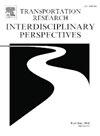Infrastructure-based sensor fusion for acquiring gross vehicle weight rating classifications
IF 3.8
Q2 TRANSPORTATION
Transportation Research Interdisciplinary Perspectives
Pub Date : 2025-07-01
DOI:10.1016/j.trip.2025.101535
引用次数: 0
Abstract
Gross Vehicle Weight Rating (GVWR)-based vehicle activity data are widely used in freight planning, fuel efficiency evaluation, and on-road emission estimation. However, existing data sources rely on either surveys or mapping from other classification schemes. GVWR classification data acquisition directly using existing highway sensor infrastructure remains challenging. To address this challenge, this paper developed an approach to acquire GVWR-based classification data through the aggregation of two complementary infrastructure-based sensing technologies: inductive loop sensors and side-fire cameras. An open-source intelligence (OSINT) method was initially adopted to establish a GVWR-based vehicle dictionary to overcome mapping challenges with classes that cannot be directly associated with singular GVWR-based classes. A dataset comprising 9,154 vehicle inductive loop signatures paired with images was then collected and annotated according to the pre-defined dictionary. Next, signature-based and image-based classification models were developed for GVWR classification, with model designed to function independently. The signature-based GVWR classification model was trained with a multi-layer perceptron (MLP) architecture and optimized through the implementation of a weighted cross-entropy loss function. The image-based GVWR classification framework was designed to extract vehicle objects in a two-stage process and classify them based on the GVWR scheme. Finally, a linear integration model was implemented to combine the output of the signature- and image-based models to achieve an improvement over each standalone classification model. The sensor integration framework significantly outperformed each individual sensing technology, achieving an average correct classification rate of 0.97 and an score of 0.96, which surpasses state-of-the-art methods.
基于基础设施的传感器融合获取车辆总重等级分类
基于车辆总重等级(GVWR)的车辆活动数据被广泛应用于货运规划、燃油效率评估和道路排放评估。然而,现有的数据来源依赖于调查或其他分类方案的制图。直接使用现有公路传感器基础设施获取GVWR分类数据仍然具有挑战性。为了应对这一挑战,本文开发了一种方法,通过聚合两种互补的基于基础设施的传感技术(电感环路传感器和侧火摄像机)来获取基于gvwr的分类数据。最初采用开源智能(OSINT)方法建立基于gvwr的车辆字典,以克服类不能直接与基于gvwr的奇异类相关联的映射挑战。然后收集了9154个车辆感应环路特征与图像配对的数据集,并根据预定义的字典进行了注释。接下来,分别开发了基于签名和基于图像的GVWR分类模型,并设计了各自独立工作的模型。采用多层感知器(MLP)架构对基于特征的GVWR分类模型进行训练,并通过加权交叉熵损失函数对模型进行优化。设计了基于图像的GVWR分类框架,分两阶段提取车辆目标,并基于GVWR方案对其进行分类。最后,实现了一个线性集成模型,将基于签名和基于图像的模型的输出结合起来,以实现对每个独立分类模型的改进。传感器集成框架显著优于每种单独的传感技术,平均正确分类率为0.97,F1得分为0.96,超过了最先进的方法。
本文章由计算机程序翻译,如有差异,请以英文原文为准。
求助全文
约1分钟内获得全文
求助全文
来源期刊

Transportation Research Interdisciplinary Perspectives
Engineering-Automotive Engineering
CiteScore
12.90
自引率
0.00%
发文量
185
审稿时长
22 weeks
 求助内容:
求助内容: 应助结果提醒方式:
应助结果提醒方式:


